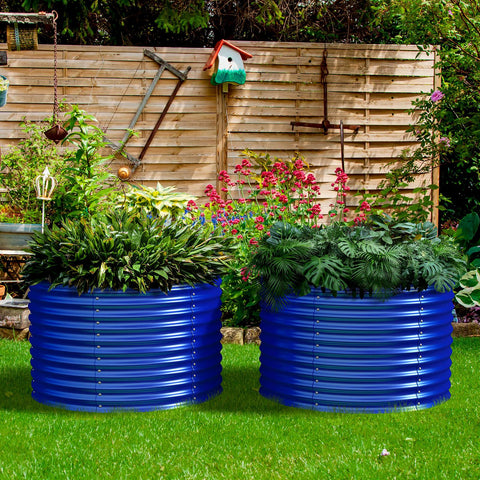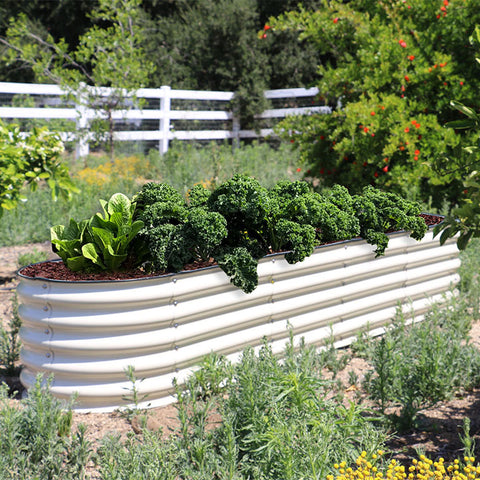How to Prepare a Raised Garden Bed for Winter
There will never be dill time in the garden! In winter, the temperature drops, making it difficult for your raised garden bed soil to adjust and play its due role. At this time, most gardeners spend time preparing raised garden beds for winter. It helps to prevent damage to soil and plants still waiting to be harvested. If healthy soil leads to healthy plants, then nutrient deficient soil will not be able to sustain plant life. This is especially true if you plant cool weather crops on raised garden beds.
Even if you plant nothing on the raised garden bed, you must still protect the soil in winter to avoid erosion and nutrient loss. About thyme, you will learn how to prepare an elevated garden bed and the benefits of the process!

Why choose a raised garden bed
Garden beds are versatile, easy to make, and suitable for any place you want. Although there are many DIY garden bed ideas, if you prefer to build your own, you should avoid using some raised garden bed materials. In other words, garden beds have many advantages.
- They help reduce soil compaction,
- They promote better drainage,
- The raised garden bed allows the planting season to start earlier,
- They are easy to maintain,
- Reduce the contact with weeds.
However, like everything else, they also have some disadvantages:
They need to be watered more frequently,
They are not completely budget friendly (depending on the materials used)
Some garden bed materials can be a health issue.
The raised garden bed is very suitable for elderly gardeners, people with mobility difficulties or people who do not want to spend too much time pulling up weeds. They are easy on the back, making them an excellent choice for growing edible crops.
Raised garden beds for winter
The cold winter temperature will reduce the soil nutrient content, microbial activity, and increase the soil salinity. Before you store gardening tools, make sure you "parsley test" by learning how to prepare an elevated garden bed for winter! The method is as follows:
- Remove all weeds
Although you often remove weeds, it is very important to pull them out at the end of autumn. This is especially true if you plan to plant winter cover crops or cool season vegetables that can be harvested and eaten in colder months.
But don't weeds in winter protect and improve soil? Yes, for non container gardening, our idea is to let some weeds grow, such as thistles and docks, to help improve the ventilation and drainage of the soil. Container gardening does not require this because the soil is easy to maintain and does not compact too much.
In addition, it is not good to let weeds grow in containers, because some seeds can be stored in the soil for decades! For example, Canadian thistle seeds can survive in the soil for more than 20 years, while annual ryegrass can survive for up to nine years.
A simple way to suffocate weeds and their seeds is to cover garden beds with dark plastic, tarpaulin, or cardboard. Cultivating soil is another option. However, it should be noted that frequent tillage will deteriorate the soil structure and health, increase the risk of runoff and erosion, and reduce the number of earthworms in the soil. Don't farm unless your soil is very compacted.
Professional tip: If the weeds you pull out of the garden look good and have no disease, please add them to the compost.
- Clean up all dead plant debris
After the first significant temperature drop, start to clean up the old plant materials. Remove all dead plant debris and add them to the compost heap, or if they are infected, sick, mouldy or have fusarium wilt, throw them away.
Rotting, diseased and infected plants are breeding grounds for bacteria, pests and fungi, which is why adding them to compost is not a good idea. Adding healthy leaves, grass cuttings and safe weeds to the compost heap is a good way to recycle plants and turn them into black gold in the garden.
Although your cold season root crops, such as carrots, beets, radishes or potatoes, will be good before the beginning of winter, be sure to harvest them on time before the ground is completely frozen.
- Add compost
Compost is called black gold for good reason! It provides nutrients and microorganisms for the soil to help it maintain plant life. To improve the soil, add 2 or 5 inches of compost to the top 1 to 3 inches of the soil. As you have learned above, frequent tillage increases the risk of soil erosion, so you must modify the soil of the raised garden bed and add a new layer of topsoil before adding compost.
- Plant covering crops or mulch
Covering crops is an effective way to fight weeds and improve soil health. However, it is important to choose the right mulch crop for your garden. Some gardeners mistakenly choose a mulch crop that refuses to die at the end of winter and becomes an aggressive weed when the temperature rises in spring.
Some of the cover crops you can plant include:
Oat
Red clover
Hairy wild peas
Ryegrass
Winter wheat
Winter pea
Sweet clover
Barley
Buckwheat
Sudan grass
If you do not want to plant mulch crops, you can put mulch on the elevated garden bed. The idea is to cover the top of the garden bed so that the minerals, amendments, organics and nutrients in the soil are not washed away or blown away.
One of the most common covering errors is the use of the wrong covering material. Natural coverings, such as grass cuttings, fallen leaves, straw and pine needles, are ideal for your elevated garden bed.

- Use the season extender
Building seasonal extenders, such as hoop houses, cold shelves and bell towers, is a good way to make full use of raised garden beds. The season extender will allow you to plant earlier and ensure your plants are safe when winter temperatures fall. Since the season extender provides extra heat for plants, you need to monitor the crops closely to ensure that they do not overheat and dry out.
- Just cover it
If you don't want to plant floor coverings or cool season crops, and don't want to spend time removing weeds, the next best way is to cover your raised garden bed with thick blankets, old carpets, tarpaulins, or cardboard layers. Covering it will suffocate and kill most weeds, but when the temperature rises, you need to restore the vitality of the garden soil to maintain plant life.
On yourself!
The elevated garden bed is a good way to extend the growing season and relax the body, especially for the elderly gardeners and people with limited mobility. They are easy to maintain, have better drainage, prevent soil compaction and weeds, and allow longer growing seasons. However, you must ensure that your elevated garden bed is ready for winter.
Happy gardening!
